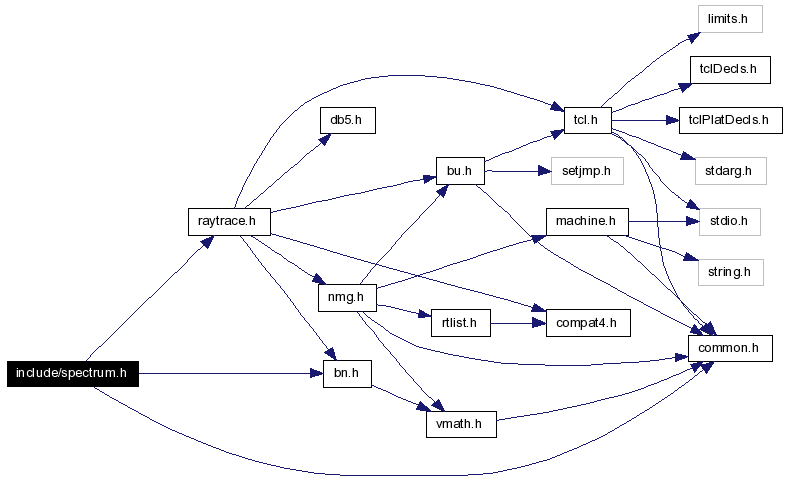
#include "common.h"#include "bn.h"#include "raytrace.h"Include dependency graph for spectrum.h:

This graph shows which files directly or indirectly include this file:

Go to the source code of this file.
Functions | |
| RT_EXPORT void | rt_spect_make_CIE_XYZ (struct bn_tabdata **x, struct bn_tabdata **y, struct bn_tabdata **z, const struct bn_table *tabp) |
| RT_EXPORT void | rt_spect_black_body (struct bn_tabdata *data, double temp, unsigned int n) |
| RT_EXPORT void | rt_spect_black_body_fast (struct bn_tabdata *data, double temp) |
| RT_EXPORT void | rt_spect_reflectance_rgb (struct bn_tabdata *curve, const float rgb[3]) |
The context is kept in an 'bn_table' structure, and the data for one particular sample are kept in an 'bn_tabdata' structure. tabdata.h provides the data structures, librt/tabdata.c provides the routines.
The contents of the spectral sample in val[j] are interpreted in the interval (wavel[j]..wavel[j+1]). This value could be power, albedo, absorption, refractive index, or any other wavelength-specific parameter.
For example, if the val[] array contains power values, then val[j] contains the integral of the power from wavel[j] to wavel[j+1]
As an exmple, assume nwave=2, wavel[0]=500, wavel[1]=600, wavel[2]=700. Then val[0] would contain data for the 500 to 600nm interval, and val[1] would contain data for the 600 to 700nm interval. There would be no storage allocated for val[2] -- don't use it! There are several interpretations of this: 1) val[j] stores the total (integral, area) value for the interval, or 2) val[j] stores the average value across the interval.
The intervals need not be uniformly spaced; it is acceptable to increase wavelength sampling density around "important" frequencies. This will undoubtably complicate certain functions.
By convention, wavelength is stored in nanometers as an integer, and power is stored in Watts.
Wavelength Units - cm = 10** -2 m centimeters mm = 10** -3 m milimeters um = 10** -6 m micrometers, or microns nm = 10** -9 m nanometers
The Spectrum in nm - < 10 nm X-Rays 10 to 390 Ultraviolet 390 to 770 Visible 770 to 1500 Near IR 1500 to 6,000 Middle IR (includes 3-5 um band) 6,000 to 40,000 Far IR (includes 8-12 um band) 40,000 to 1,000,000 Extreme IR > 10**6 nm Microwaves (300 GHz to 300 MHz) > 10**9 nm Radio waves (300 MHz and down)
It is tempting to store the wavelength in nanometers as an integer, but that might preclude very narrow-band calculations, such as might be required to study a single spectral line, and it might also preclude future extensions to X-rays. Because there are likely to be very few bn_table structures in use, the extra storage isn't a likely problem. The worst effect of this decision will be floating-point grunge when printing wavelengths, e.g. 650nm might print as 649.99nm. On the other hand, non-integer values might make it difficult to determine if two wavelengths from different curves were the "same", without introducing a wavelength "tolerance" notion. Ugh.
Definition in file spectrum.h.
 1.4.6
1.4.6